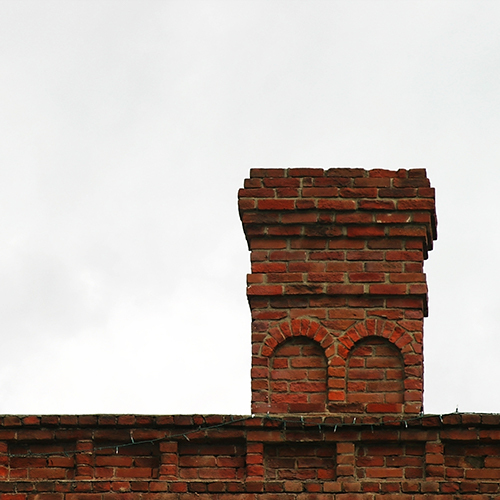
Chimneys have been staples in home construction for decades, particularly in pre-war homes where they were the only source of heat during the cooler months, but most people don’t give them much thought. In this post, I’m going to answer a simple question for, how does a chimney work?
In the past I’ve written about Rumford fireplaces which are a pretty unique design, but we’ve never delved into the mechanics of how a chimney works and why.
You may be having problems with your chimney. Maybe it’s not drafting well and creating a smokey house, maybe the bricks in the firebox are damaged. Whatever the issue, you need to understand how your chimney works before you can go about solving the issues.
A Beginner’s Guide to Chimney Anatomy
The premise of this home construction staple is simple – a chimney is supposed to carry hot air and gasses from fireplaces out of the home. There’s actually a little bit of science behind this called the stack effect.
The stack effect essentially works the same as a hot air balloon does. Hot air rises, so when air is heated by the combustion of the fireplace, the smoke and gasses will naturally rise up and be replaced by cooler air to keep the cycle going. The stack effect is also why drafting your hearth is important, as well as why having a flue is necessary for chimney anatomy.
What Are Flues?
The flue is the middle part of your hearth, otherwise known as the stack that rises out of the roof of your home. The flue is passage between the firebox and the outside, which makes them essential to directing the hot air produced by the stack effect into the outdoors.
Flues are necessary because they make sure harmful smoke and gasses caused by using your fireplace are directed upward and out; without a flue, all of that smoke would be trapped inside the house.
While flues are essential to proper ventilation, other important anatomy terms to keep in mind include:
- Chimney cap – What protects the flue from water and wildlife
- Damper – Used to open or close the flue
- Firebox – The section of the fireplace where the fire burns
- Grate – Placed into the firebox to hold wood and allow airflow
Should You Have a Chimney Cap?
Yes, you absolutely should have a chimney cap. On traditional brick flues, the flue cap is installed directly into the crown of the stack and prevents water, wildlife, and vegetation from getting into your flue to cause an unsafe blockage.
Flue caps generally have a flat top or other decorative brick design to allow for ventilation of smoke, while still offering enough protection from the elements that your hearth will work correctly even when it’s damp outside.
What About Flue Liners?
A flue liner is typically a terra-cotta lining to the chimney to protect the walls of the chimney form the heat and harsh gasses that need to travel up your flue.
This smooth lining cuts down on creosote buildup and protects the brick from premature wear and tear. Some chimneys in historic houses do not have a flue liner and having them inspected by a local chimney sweep prior to using the fireplace is really important to make sure that they are safe for a fire and will draft properly.
How to Resolve Drafting Problems
Speaking of drafting this is usually the number one issue people have with their chimneys so I felt that it would be worth discussing because not knowing how a chimney works, you may not know that the causes of a drafting problem may be something simple to resolve. The main reasons (and DIY fixes) for drafting problems include:
1. Cool Air Conflict
The stack effect relies on the ability to pull cool air into the firebox. However, when you have competing draws on which appliances are getting the cool air in the room, you can create a backdraft problem. A good example of a cool air conflict is using a fireplace and an air vent at the same time in the same room.
The Fix: Remove the Conflict
This is probably the easiest fix on the list. If your backdraft is caused by cool air conflict, simply turn off the appliance competing for the cool air when you want to use your fireplace.
2. Blocked or Clogged Damper
The damper is what closes or opens your flue between uses, which is what protects your fireplace from the elements. However, dampers may be blocked by nesting critters or from long years of disuse. Sometimes a backdraft is caused by forgetting you have the damper closed.
The Fix: Unblock the Damper
Your first step is to open up the damper and see if that fixes the problem. If you’re certain the damper is open and you’re still having backdraft problems, you’ll want to clear and clean your flue of any blockages on the damper.
3. Dirty Cap
When your flue cap is dirty, hot air has no way of escaping the flue and that’s what leads to your backdraft problem. Dirty caps can be caused by years of creosote build-up, rust, or gunk trapped against the cap.
The Fix: Clean the Cap
Cleaning the cap will clear up the grates in the cap that allow for ventilation when the fireplace is in use. You can clean the cap with steel scrubbing sponges or anything else that will scrape off whatever is blocking the grates.
4. Improper Grate Ventilation
Speaking of grates, if you’re burning wood in your fireplace, then you need to be using a grate to do so. A common cause of backdraft is simply not using a grate. Grates lift wood off the ground, which gives the underside of the wood a place to pull in cool air to facilitate the stack effect. No grate means no ventilation, and that means smoke in your house.
The Fix: Position Fire Grate Correctly
Use a grate when you are burning wood and make sure to position the grate correctly in the firebox. The ideal location for a grate is about 1 inch away from the back of the firebox.
Keeping your chimney and fireplace clean can do wonders to keep everything working correctly. Check out this post about how to properly clean your fireplace if you’re unsure exactly what to do.
I know that the TV has become the center of the house, but in the old days it used to be the fireplace. So, even if you don’t use it as often as they did when your old house was built it’s still important to understand how a chimney works so that when you want you can get that fire roaring again on those cold winter nights.

Founder & Editor-in-Chief
I love old houses, working with my hands, and teaching others the excitment of doing it yourself! Everything is teachable if you only give it the chance.


We just had the three chimneys rebuilt on the 1860 Italianate we purchased in 2018. We’ve had them inspected and are very excited to have working fireplaces down the road. Slowly, and steadily we are working on this home we love so much. Furnace, roof, chimneys, now beginning tuckpointing. We can’t wait to begin windows. Most are original to the home.
Hey Scott. Thanks for the article. Just moved into a 1947 home where the fireplace hasn’t been used in 10 years.
What type of license or credentials are recommended when hiring chimney inspector and/or repair company?